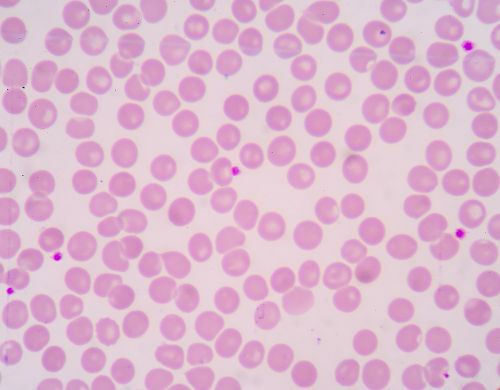AtRed Cellsare blood cells also known as red blood cells or erythrocytes.They play an important role in tissue oxygenation, being also responsible for the red color of the blood.
→ Red blood cell characteristics
At Red Cells they are rounded cells, shaped like a biconcave disc, which are about 7.5 µm in diameter and 2.6 µm thick in the peripheral region and about 0.8 µm in the central region. The shape of the red cell increases the contact surface, ensuring more efficient gas exchange. In addition, red blood cells are flexible, which facilitates transport.
Red blood cells also stand out for their absence of nucleus and, therefore, absence of genetic material. Because of this feature, red blood cells are cells that live for a short period of time and are unable to divide.
The red color of red blood cells results from a red pigment called hemoglobin. Hemoglobin is a protein formed by four subunits that have a protein portion linked to a heme group, which contains iron. It is this protein responsible for ensuring the transport of oxygen throughout the body.
Red blood cells are produced (erythropoiesis) in the bone marrow and, after an average period of 120 days, its destruction occurs, which is carried out in the liver and spleen. In these places, hemoglobin molecules are broken down and amino acids and iron are made available, which can be used to manufacture new red blood cells.

Red blood cells are the most numerous blood cells in the blood.
→ Red blood cell functions
Red blood cells have as their main function the oxygen transport obtained by the respiratory system to the cells of the body. It is also the role of red blood cells to transport a part of the carbon dioxide produced by the cells so that it can be eliminated. It is worth noting that a large part of the carbon dioxide produced in tissues is transported by blood plasma.
Upon reaching the lungs, more precisely the pulmonary alveoli, hemoglobin binds to oxygen molecules, forming the oxyhemoglobin. In tissues, hemoglobin combines with carbon dioxide, forming the carbohemoglobin.
→ Anemia
Anemia is the name given to diseases that are characterized by the low amount of hemoglobin in the blood. This problem has several causes, such as a diet with a low amount of iron or even low production of red blood cells, exaggerated destruction of these cells and severe bleeding.
In anemia, oxygen transport is affected and, consequently, cells carry out the cellular respiration process in lesser amounts. Without intense cellular respiration taking place, less energy is produced and the individual experiences greater weakness and fatigue.
It is also worth noting the existence of the sickle cell anemia, a hereditary disease characterized by deformation of the red blood cell, which in this case presents the shape of a sickle. This change in the red cell causes it to become less flexible and more fragile than the normal red cell, which triggers the rapid destruction of that blood cell.
CURIOSITY:VDid you know that red blood cells are the most numerous blood cells in the body? In a normal individual, there are about 4 to 5 million of these cells per deciliter of blood. It is because of the large amount of red blood cells that our blood turns red.
By Ma. Vanessa dos Santos
Source: Brazil School - https://brasilescola.uol.com.br/o-que-e/biologia/o-que-sao-hemacias.htm
